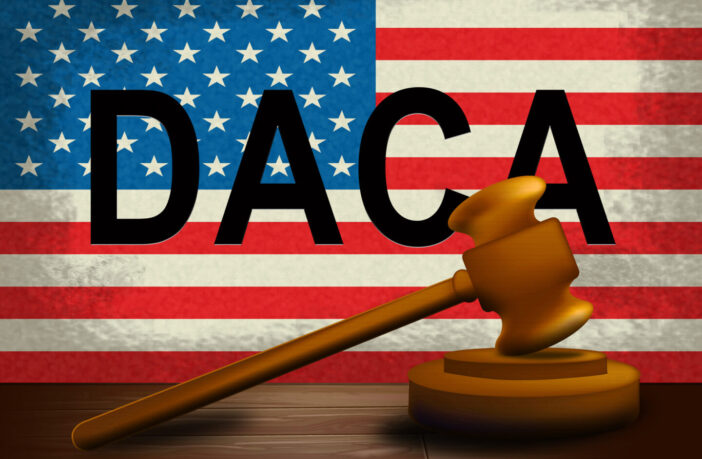Nine years ago on this very day, President Obama unilaterally created Deferred Action for Childhood Arrivals (DACA) to provide amnesty to certain illegal aliens who arrived in the country before the age of 16. The program protected these illegal aliens from deportation for two years, renewable terms, and also gave them temporary work permits. At the time, amnesty was largely unpopular with the American people and President Trump eventually tried to end the unconstitutional program but was thwarted by activist judges.
Then, on President Biden’s first day in office, he signed an executive action ordering government officials to maintain and strengthen DACA. President Biden’s memorandum asked the Secretary of Homeland Security, in consultation with the Attorney General, to take all executive actions he deems appropriate to preserve and the fortify the unconstitutional amnesty.
Here are nine important facts about the DACA program:
(1) At the time the Trump administration announced it would no longer be accepting new applications for DACA, the population of beneficiaries totaled about 690,000, with about 800,000 individuals benefitting from the program since its inception. As of December 2020, the Migration Policy Institute estimates that there are 636,390 active DACA beneficiaries with an eligible population of at least 1,331,000 illegal aliens. Because the age requirements were put in place in 2012, the age range of eligible beneficiaries spans from 24 to 40 years old. No DACA recipient or DACA-eligible alien in 2021 is a minor.
(2) The unlawful creation of the DACA program has been a leading driver to the humanitarian crisis on the U.S.southern border. Historically the majority of illegal border crossers were single adult males, while CBP reported very few apprehensions of family units and unaccompanied alien minors (UACs). These trends changed drastically, beginning in 2013, shortly after the administrative-creation of the DACA program. Beginning in 2013-2014, the numbers of UACs and family units arriving at the southern border reached crisis levels, and have remained alarmingly high, spiking again in 2018-2019, and at its worst in 2021.
(3) Advance parole remains an administrative loophole that has allowed as many as 40,000 DACA recipients receive green cards, despite never having a lawful immigration status in the United States. The Immigration and Nationality Act requires that an alien be inspected and lawfully admitted or paroled into the United States in order to be able to receive a green card. Because of DHS regulations that allows illegal aliens, including DACA recipients, to leave the United States and return, they are able to later be considered “inspected and lawfully admitted or paroled,” thus, allowing aliens who have entered illegally to adjust status in stark conflict with Congressional intent.
(4) While most open borders advocates portray the DACA program as only befitting those who were a just few years old when they came to the United States illegally, the program only required that an illegal alien provide evidence that they entered the United States before their 16th birthday. In fact, many DACA recipients were raised in their native country and nearly college age before entering the United States.
(5) Open borders advocates have consistently referred to DACA recipients as “children” to put them in a more sympathetic light. While DACA recipients were minors when they entered the United States, the overwhelming majority of DACA recipients are in their 20s and 30s. Illegal aliens were eligible for DACA as long as they were under the age of 31 as of June 15, 2012. Today, the average DACA recipient is 27 years old, while the oldest recipients have recently turned 40 years old.
(6) The mass-immigration lobby relies heavily on the myth that DACA recipients are just as proficient in English as any other U.S. native. They also contend that the average DACA beneficiary is generally unable to speak their native language and is a stranger in their home country and to their family’s customs. This myth has been sustained to bolster the argument that DACA beneficiaries would undergo exceptional hardships if the U.S. government returned them to their home countries. However, these contentions ring hollow. The DACA program did not require recipients to be fluent in English. An investigation by the Center of Immigration Studies revealed that approximately 24 percent of the DACA eligible population can be categorized as functionally illiterate in English and 46 percent have only basic English skills.
(7) Mass-immigration amnesty groups also depict DACA recipients as a well-educated group that contributes positively to the economy. Reality paints a different picture. Only 49 percent of DACA recipients have a high school education. The Obama administration routinely waived the education requirement of the program as long as the illegal alien was enrolled in some educational program at the time of applying. Thus, providing amnesty and eventually citizenship to low-skill and low-English proficient illegal aliens is nearly guaranteed to come at a high cost to American taxpayers through public service and benefit spending that their continued presence and newly lawful status will require.
(8) Documents obtained by Judicial Watch have also uncovered the Obama administration performed what can only be referred to as a “lean and light” background investigations process in order to rubberstamp as many DACA application approvals as possible. In the first few years of the programs existence, application approval rates were near 98-99 percent, rejecting only applicants that had a substantial history of criminal convictions in the United States.
(9) Many legislative proposals that claim to address the DACA population are too broad. For example, the most publicized bill floating out there, known as the American Dream and Promise Act would grant a pathway to citizenship to roughly 3 million illegal aliens.





1 Comment
Pingback: 9 Important Facts About the DACA Amnesty Program | 198 Immigration News